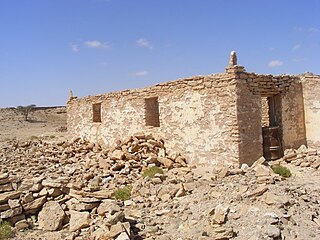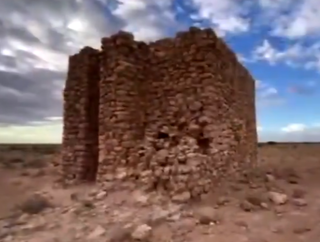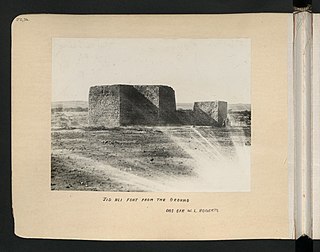
Las Anod is the administrative capital of the Sool region of Somaliland.
The Warsangali is a major Somali sub clan, part of the Harti clan which itself belongs to one of the largest Somali clan-families - the Darod. In the Somali language, the name Warsangali means "bringer of good news." The Warsangeli primarily inhabit the far eastern area of the Sanaag region.
Dul Madoba is a hill ridge 40 kilometres (25 mi) southeast of Burao in Somaliland. It was also the location of a famous battle in which the Dervishes won a victory against the British, and wherein Ibraahin Xoorane killed Richard Corfield. A native Somali account of the battle is found in the poem Annagoo Taleex naal.
The Ogaden is a Somali clan part of the Darod.

Sayid Mohamed Abdullahi Hassan was a Somali religious and military leader of the Dervish movement. It was subdivided into 13 administrative divisions, of which the four largest were Shiikhyaale, Dooxato, Golaweyne and Miinanle, a setting which in the midst of colonial expansionism eventually set the stage for a two-decade long confrontation with various colonial empires including the British, Italians, and Abyssinians.

Harti, meaning "strong man", is a Somali clan family that is part of the Darod clan. The major sub-clans include the Majeerteen, Dhulbahante, Warsangali and Dishiishe, while other minor sub-clans consist of Kaskiqabe, Geesaguule and Liibaangashe.

Taleh is a historical town in the eastern Sool region of Somaliland. As of September 2015, both Puntland and Somaliland had nominal influence or control in Taleh and it's vicinity. The town served as the capital of the pre-independence Dervish movement.

Buuhoodle, also known as Bohotle, is a city in the Togdheer region of Somaliland. It is a prominent border town for movements of goods to and from Somaliland and the Somali Region of Ethiopia. The surrounding district is rich in both livestock and fledgeling agriculture.
Richard Conyngham Corfield was a British colonial police officer who saw service in South Africa, Nigeria, India, Pakistan, Kenya and Somaliland in the early 20th century. His death at the hands of Darawiish Ibraahin Xoorane and Axmed Aarey was chronicled in the poem Annagoo Taleex naal.
Haroun, also called Fadhiweyn, and natively transliterated as Xarunta in Somali, was a government and headquarters of the Dervishes, headed by Faarax Sugulle. The Darawiish monarch was Diiriye Guure, based in Taleex. According to Claude Edward Marjoribanks Dansey, the political officer in the British Somali Coast Protectorate consisted of 400 individuals.
Haji Yusuf Barre was the commander at the battle of Jidbali, the largest and deadliest engagement between the dervishes and the British empire in the Horn of Africa. Haji Yusuf Barre is also noted for being the person whom held the last stand at the Dhulbahante garesa at Taleh, in the aftermath of the bombings at Taleh wherein Taleh became the first place to be targeted in Africa through aerial attacks.
Kaladi Madlay was the head of a portion of the Huwan region in the early 1900s decade as well as the highest ranked avowed Ogaden within the Darawiish in the early years of this decade until his purported desertion in 1903. He was succeeded as leader of the Huwan region by Hamed Sultan.
Ciid or 'Iid is an archaic native geographic name for the land between the region of Mudug and the Nugaal Valley, roughly congruous with the northern Bookh district in Ethiopia. As such, Ciid constitutes the tripoint of the former three colonial powers Abyssinia, Britain and Italy, thus situating Mudug immediately southeast of Ciid, the Nugaal Valley immediately north of Ciid, and Haud to the west of Ciid. One historian referred to it as the syrup-colored land and it is today embodied by Ciid towns such as Xamxam, Magacley, Qoriley, Biriqodey, Beerdhiga and Gumburka Cagaare. Ciid constitutes the northernmost parts of the disputed Somali-Ethiopian territory outlined in the 16 May 1908 Italo-Ethiopian border agreement also called the 1908 Convention. A 2001 Journal from Indiana University describes Ciid as partially overlapping with Boocame District by referring to Ciid as north of the Mudug region and the west of the Garowe region.

Dalyare fort is an open-top Dhulbahante garesa of the Darawiish era which was ordered built by Diiriye Guure as a strategy for countering the colonization efforts of the Europeans. The building is located in the Nugaal Valley a few miles east of Las Anod. The purpose of the Dalyare fort was to serve as a refuge and escape route for Darawiish retreating from colonial forces who intend to head south towards the Shabelle River. However, retrospectively, some analysts have described the building as a setback to the previous tactic of maneuverability on the part of the Darawiish. Cali Jalax was the builder. The native Darawiish referred to the building as Sool-Daryare. On the other hand, the colonialists who launched attacks against the Darawiish referred to the building as Dariali.

Jidali fort was a cross-shaped fort of the Dervish era located in the town of Jidali in Sanaag, Somaliland and is also the first place in Africa to be bombed via aerial bombardment by a tally of four sorties of De Havilland DH-9's on 21 January 1920. An April 1920 letter between the Sayid and Italian-Somali governor Giacomo De Martino states that the Dervishes built a total of twenty-seven forts which are described as Dhulbahante garesas.
Adan Ali Gurey was a political advisor in the Darawiish, an anti-colonial instigator, the commander of Golaweyne, a chieftain of the Dhulbahante, and an arms supplier.

Dhowre Ali Sheneeleh was the castellan of the Darawiish fort / Dhulbahante garesa of Eyl, whilst the governor of Nugaaleed-Bari for the Darawiish was Ali Meggar. He was also the primary commander which spearheaded opposition to Abyssinian expansionism towards the east in the 1900s.
The Mohamoud Garad is a Somali clan. Its members form a part of the Dhulbahante, a sub-division of the Harti/Darod clan-family. The clan is divided into three major sub-clans ― namely the Jama Siad, the Naleye Ahmed and Galool Oriye.
The Farah Garad or Garad Farah is a Somali clan. Its part of the Dhulbahante clan-family, a sub-division of the larger Harti/Darod clan. The Farah Garad are divided into three major sub-clans — Ahmed Garad, Baharsame and Barkad. Numerically, the largest of these three subclans is the Ahmed Garad, which itself subdivides into Ararsame and Ali Gheri.
Garad Jama "Farah" was the 18th garad or sultan of the Dhulbahante Garadate, from the 1920s until 1960. His surname isn't Farah, but he acquired the title to distinguish Farah Garad from the garad/sultan of the equally sized Mahamuud Garad clan and that of the Bah Nugaal clan.








